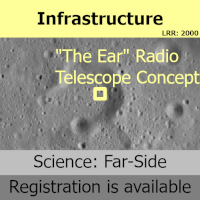Prime Site for an Observatory on the Far-Side of the Moon called The Ear. Don’t Look Up – Look OUT.
“The Ear” is a Partnership Science Registration for a proposed research location, created by Lunar Resources Registry and Lunar Station Corporation. Visit their LinkedIn page to find out more.
Visit the Ear Radio Telescop registraiton on Lunar Resources Registry.
The location is on the far-side the Moon, where the planned observatory has less interference from the noise of Earth.
It is nestled in a shallow Ear-shaped crater, making the location ideal for a Scientific Observatory operation, be it a Radio Telescope or Asteroid Detection Observatory, or both.
The Scientific Registration is open to space agencies, the scientific community, and potential designers and manufacturers of the hardware required for Radio Telescope or Asteroid Detection Observatory.
The far side of the Moon is thought to be a convenient location for a low-frequency radio telescope. It’s not exposed to radio transmissions from the Earth. An absence of lunar atmospheric and ionospheric noise enables ultra-long wavelength observations. Radio frequency interference is produced by human activities, such is the case on the Earth with the use of military and commercial transmitters, satellites, or cell phones. Additionally, because of the Moon’s synchronous rotation, the far side is never faced towards the Earth. It will never be affected by the volume of noise and interference affecting Earth observations. Another critical function of a radio telescope located on the lunar far side would be detection and prediction of potential collision with astronomical objects like e.g. Asteroids, and Near Earth Objects.
What Hardware or Space Craft would you like to see launched to the Ear?
If you have a scientific, academic or commercial idea of what existing (or soon to be) hardware, including configurations, could fulfil the purpose of a Far-Side Radio Telescope and / or Asteroid Observatory, leave a comment below or contact Lunar Resources Registry directly. Note: Assume an operation lasts at least one Lunar night.
Below are two Lunar Analytical Images from Lunar Station Corp.



